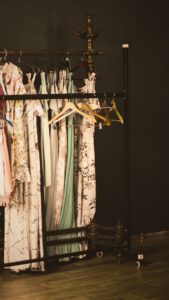Affiliate Disclosure
Some of the links on this page may be affiliate links. As an Amazon Associate, I earn from qualifying sales from these links. If you make a purchase or sign up for a membership through these links, I will receive a small commission. This will not cause any additional costs for you. This income helps us to run this website and especially the blog for you.
The problems
I have really seen some closets. From women in my family and friends, for example, and they all had several things in common. Here’s a partial list of 7 “wardrobe problems” or “styling issues” that I’ve seen happen in this or similar ways more often, and possible solutions:
Problem 1: Repeat purchases.
Styling problem number 1: Many parts are at least duplicated, if not umpteen For example, 5 black pants. Two stacks of very similar blue jeans. Four pink dresses very similar, etc.
Solution:
For this styling problem, it helps to take inventory. Write down all existing parts with quantity. Then sort out duplicate parts. Of course, only if you do not want or need to wear the same thing every day in a professional context. But if you wear and want to wear a black pants, for example, only two days a week, then you probably do not need 5 black pants.Then, in my opinion, one black pants would be enough. I would then keep the pants that I really like the most, that have the best quality and sort out all the others.In the next step, I would make a plan with a list of pieces that I think are missing in my wardrobe and these I would then at best always have with me, so that I can also take a look at it at any time during a spontaneous shopping trip.
Problem 2: Almost everything in the same color
Styling problem number 2: The wardrobe is extremely one-sided. All parts are in the same color or only slight gradations of one color. E.g. everything in black or almost everything in gray etc.
Solution:
Again, with this styling problem, it helps to write a plan. If you have already made an inventory, you can already see how many parts you have in the same color. Then I would try to get to the bottom of it a little bit. So ask myself the following questions: Why do I always reach for color xy?
Do I feel particularly good in it, or do I just reach for it because I think I can’t go wrong with it? Alternatively, what colors would I like and at best match the existing parts/colors?
Especially if you tend to always reach for the same color, I think you should take it slow when integrating other colors.
First of all, there is absolutely nothing wrong with having a favorite color that you like to wear. This only needs a “solution” at all if you don’t really find your wardrobe gt, but don’t know exactly why you don’t feel comfortable with it. I myself have worn black almost exclusively for a long time.
But today I don’t feel comfortable in black at all, or at least not really well. Wearing something black every now and then is ok for me, but it’s not my favorite color. Why I used to wear a lot of black had rather different reasons. It just always fit almost every situation on the one hand. You are rarely underdressed or overdressed in black. It is also rather “quiet”. You don’t really draw attention to yourself with it in most cases. Of course, there are also extreme styles in black, but I’m talking about pretty “normal” outfits here. Black is also mostly easy to clean and stains don’t really stand out on it. Black is also kind of non-sawing.
Nobody would criticize if for a black trousers or a black pulle. So my problem was my lack of self-esteem which with black wardrobe created a kind of comfoftzone from which I dared not approach. Of course, this was just my experience and not everyone who has a color biased wardrobe has a lack of self-esteem, but it can be a reason. Clothing is a comfort zone for us. What we wear has a significant impact on how we feel. Whether we feel safe and confident, or whether we feel attractive or even belonging to others. If you are affected by a color one-sided wardrobe and not completely satisfied with it, then my tip would be: do not try to integrate several other colors at once on compulsion.
Probably most parts of it will become unworn mis-buys. Rather, try to find a similar color that you like and integrate a few pieces in that color and gradations of it for now. So if you own e.g. really almost only black parts or also gray, then try to find first e.g. 3 parts in blue, which you like. E.g. a pair of dark blue pants, a blue blouse or a blue t-shirt etc. And then try to get used to these parts for a few months. If this works well, integrate another color in the same way.
In general, I think that a wardrobe does not necessarily need a lot of colors. Three different color groups are quite enough to get an interesting wardrobe.
Problem 3: Too colorful and inconsistent
Styling problem number 3: The opposite of problem 2. The garments all have different colors and maybe even patterns. Nothing is really coordinated.
With such wardrobes , you often have this feeling of “not having anything to wear”, even though the wardrobe fits almost out of the seams. This is what happens when people like to go shopping in their free time and are easily seduced by visual stimuli in the stores. When experts dress mannequins or do store fitting, an incredible amount of strategy goes into it. I know this because I have done this job myself. I worked as a display designer or in visual marketing, in furniture stores as well as various clothing stores. Often matching outfits also hang together in such a way that all parts are optimally coordinated with each other. But customers don’t always buy whole outfits. For example, you then buy only the dress with the floral print. But not the matching cadigan and shoes.
Then the dress hangs in the closet, but you have neither suitable shoes, or the weather is too cool and the matching cadigan is missing. Or worse, it does not suit you at all and you somehow notice that you do not feel really good in the part. The reality is, unfortunately, just because something looked good on a mannequin, it does not always look good on you. Especially with colorful and patterned parts you also unfortunately often have the problem that you can see them time. Say they are often trendy parts that, unfortunately, were in demand only temporarily.
Solution:
With this styling problem it helps to determine the own color type or let determine would help thereby very much. From the individual color palette, I would then try to filter out a number of colors or color groups. I would subsequently reduce the wardrobe to these colors.
Since patterns generally don’t combine well, I would limit myself to one or two types of patterns. So if you like striped things, I would not still buy plaid, dotted, tabby and floral parts. But leave it at different stripes patterns. I always prefer to keep it simple. This is my personal preference. If you love wild patterns in all different variations, then of course stick with it.
Problem 4: Mispurchases
Styling problem number 4: There are many unworn pieces in the wardrobe. In wardrobes where this was the case, I could usually find the following problems. Garments were purchased in the wrong size . The clothes were bought for specific, purely theoretical occasions. Clothes were bought on a spontaneous whim or one was influenced by someone or something to buy the garment.
You end up with pieces that don’t fit properly, or for which there is no opportunity to wear them at all, or in which you feel dressed up. And then, understandably, you don’t put them on.
Solution:
With this styling problem, I would recommend always buying the things in the really right size. If something still doesn’t fit (again) after twelve months, it probably never will. If parts no longer fit, set a deadline for when you would like to fit back into that particular part. Or have the piece fitted by a seamstress, if that’s possible. If something doesn’t fit right, you’ll never really feel comfortable in it.
I actually had evening dresses in my closet in the past that I bought on the spur of the moment, thinking the next wedding or celebration was already coming and thus an opportunity to wear one of these beautiful dresses.
But then I got pregnant, and then Covid came along, and when there was finally another wedding that I could have worn one of the dresses to… theoretically. Because practically, 5 years after the purchase and one pregnancy later, I no longer fit into any of these dresses, either physically or in terms of my personality. If you’re prone to such bad purchases, you probably subconsciously feel the need for more variety in your everyday life.
You don’t really pass by an evening dress by accident, you don’t just try it on for fun to hang it away again in case it looks great on you. You pick it because you want a reason to have it hanging in your closet to wear, or at least because you want to suggest that to yourself. Anyway, in my opinion, this is very often the case with bad purchases of parts for which you don’t actually have a real reason.
My tip for this would be. First create a special occasion, of course you can’t do that if you want an invitation to a wedding, of course, but you could go to a philharmonic concert, for example, or to a vernissage or an art exhibition. And only when you have found and firmly scheduled a special event, you go shopping for a dress especially for it. Then you have even double the pleasure, because you can not only enjoy the new dress but also the anticipation of the event.
If you tend to make impulse buys, again a wardrobe plan will help. And if you are too easily influenced or badly advised. Would it perhaps be advisable to go shopping alone or vice versa if one tends to make bad purchases alone, one could ask a friend for help, for example, or ask a saleswoman more often. What I like to do when in doubt, I take a picture of me and him changing room, with the part. Then I let it hang back and move on for now. Only when I later look at the picture seriously, think that I really like it, I go zück and buy the part.
Problem 5: No signature style available
Styling problem number 5: I this is the problem that there are too many “wrong” parts. There are altogether very very many parts, but felt one has “never what to wear”.
If this is the case, it can basically be due to all the problems mentioned so far and the fact that you just haven ‘t found your personal Signitaure Style yet.
Solution:
I would create one or more mood boards for different life or everyday situations with outfits and styles that I really like. I would also try to find personal style role models. The outfits from the mood board and the style role models I would then break down to their individual parts and features and list them.
And then match that list with my own clothing inventory list. What parts might be completely opposite? What really doesn’t fit the desired aesthetic at all could perhaps even be soertien. What pieces are still missing to achieve a similar look?
Problem 6: The parts do not fit the actual life situation
Styling problem number 6: Only part of the wardrobe is worn regularly, but not because you don’t like or fit the pieces, but because the current life situation doesn’t fit the clothes. This can happen if, for example, you change jobs and instead of working formally in the office, you suddenly only work in your home office and could easily do so in sweatpants. Or when, as already mentioned above with the example of evening dresses, items of clothing are purchased for purely hypothetical scenarios. Whatever the reasons.
Solution:
Even if it is difficult. With this styling problem, the only thing that helps is to deal with reality. Maybe the life situation is only temporarily changed, then I would not immediately sort out half my wardrobe. But if the likelihood is rather low that suitable occasions still or again arise, then my tip would be a maximum of 20% of the wardrobe should be parts that you rarely wear or keep for special occasions. Often, however, it is the other way around for many. 20% of the wardrobe is worn regularly or constantly and 80% of the garments are worn rarely to at.
Problem 7: Quantity before quality
Styling problem number 7: I’ve seen this so many times and it still surprises me. Closets upon closets upon closets of clothes and shoes. But all the parts are made of low quality materials and from fast fashion brands.
The problem is not only that you really don’t do yourself any favors, because you still spend a lot of money without really getting anything of lasting or at least long-term value for it, but you also harm the environment. Fast fashion pieces rarely look really good on closer inspection and they usually don’t age very well either. After a few washes, they are usually only suitable for the garbage can, because in the meantime not even aid organizations want to receive such garments as donations, because they themselves are unsuitable for various reasons and there are simply already masses of them.
Solution:
This styling problem is also predominantly a minimum problem in my opinion. If you have the feeling or need that you would rather spend 500€ for 100 pieces, instead of a maximum of five pieces, for example, then you probably have the feeling that you are always in short supply and never have enough. And by that I mean not only enough in the form of quantity, but also enough in the form of variety. Then there is simply never a feeling of satisfaction and one has had enough.
If you have problems with this, the only thing that really helps is personality work and getting to the bottom of the real problems that underlie this minimum. Often people affected by this are also not good at postponing a reward feeling.
There was a very well-known experiment on this many years ago, in which researchers placed children individually in a room at a table.
In front of them was a marshmello. They then told the child in question that they would be left alone for a quarter of an hour and that they could eat the marshmello at any time, but that they would get a second one if they didn’t finish the first one by the end of the time. Only a very small part of the children were disciplined enough to leave the marschmello to get a second one at the end. Years later, they re-interviewed the same children, now as adults, and found that the few children who were able to postpone this “reward,” that is, who were able to endure temporary discomfort, that these were significantly more successful and satisfied in their lives.
I think this behavior can be trained.
What helps is, again, as already mentioned umpteen times to create a wardrobe list. But this should not simply list things you need, but describe the parts very specifically. You can also choose certain parts and turn them into goals, so to speak , which you can work towards for longer and save if necessary.
Most of us probably always have 5-30€ available for a cheap piece, but if you tend to want to give yourself this short-term “reward or satisfaction” with it, then you can consciously try firstly not to visit those stores that mainly offer cheap clothes and secondly, as already suggested, to work towards a special piece of your own wish list and save for it.
The feeling of finally being able to afford this one special piece and wear it after weeks or months is so much better than buying and owning 10 cheap pieces in the same time that really don’t do anything for you. Once you experience that and know the difference, how you rather not want to go back to the spontaneous fast fashion purchases, at least that’s my opinion.
Conclusion
You could certainly add to this list, but I think these are the factors where you can easily make a big impact if you change them. As mentioned several times, there is no “right” or “wrong” in doing what feels right to you. But I hope that my tips were helpful for you. If you have any questions about it, feel free to write me in the comments. Also, if you would like a special topic for an article, feel free to let me know.
I wish you a relaxing weekend.
All the love
Christina
“I dress for my image. Not for myself, not for the public, not for fashion, not for men.”
Marlene Dietrich
Share this post:

We’re excited
to share our news with you!
Would you like to receive information about our latest articles and our latest products directly in your mailbox?
Sign up for our newsletter!
We’d love to keep you in the loop.
About the author

Christina Ernst is founder and CEO of Linen & Quince. She is also a designer, author and real estate expert. She shares her experiences and knowledge not only on our Linen & Quince blog, but also on her personal blog, christinaernst.net , where she writes about financial knowledge, starting a business, real estate knowledge and personal development. She loves interior design, art, antiques, as well as elegant, sustainable and high-quality fashion.



